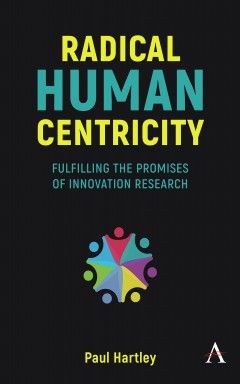Radical Human Centricity
Fulfilling the Promises of Innovation Research
By Paul Hartley
- About This Book
- Reviews
- Author Information
- Series
- Table of Contents
- Links
- Podcasts
About This Book
The book Radical Human Centricity sits between two worlds: business and anthropology. It is a critique and reassessment of commercial innovation research from an anthropological perspective born out of years of experience in innovation research consulting and anthropological scholarship. It demonstrates the many failures of contemporary commercial research, from market research to research approaches in design thinking and human-centered design. After identifying the key problems, it provides a set of solutions to elevate commercial research and allow practitioners to fulfill the empty promises of design thinking and human-centered design. The book ends with a clear articulation of how to fix what is broken and actually be human-centric, just now from within the radical human-centric approach.
This book is written for two audiences. The first is a business reader involved in innovation and strategy. It helps this business reader to understand the growing problem lurking in commercial research and offers practical advice to develop a research practice better able to fuel innovation, strategy, and design processes than anything currently available. It provides a practical and theoretical engagement with research practice to change how companies study human lives. It identifies the many gaps in more typical research methods, fills them with new tools and approaches from anthropological and ethnographic practices, and finally contextualizes them within an end-to-end radically human-centric research process.
The second reader is an anthropological scholar or student interested in the applied anthropological practices in commercial research. This is an increasingly important area of theory and practice within contemporary anthropology, and few books in this area are written by practicing commercial anthropologists. While the theoretical treatments will be known to an advanced anthropological reader, it applies them in contexts and examples not commonly discussed in the ethnographic disciplines. Additionally, the methodological examples and practice anecdotes introduce the reader to a world few academic researchers ever experience. Consequently, this book adds insight into an area of anthropological practice not well understood by academic social scientists and offers a window into new avenues of applied anthropology.
The purpose of this book is to create a space for a new form of applied commercial ethnography, called radical human -centricity. It is unique in that it addresses the problems of business research in a thoughtful, scholarly way, while also providing practical examples for innovation researchers of all backgrounds to emulate.
Reviews
“This is the book every entrepreneur and innovation worker needs to read. Engaging with people properly is essential to providing innovative solutions for your customers, and doing it right the first time can save you blood, sweat, and tears.” —Maryam Nabavi, CEO and Cofounder of Babbly.
“This book is making a valuable argument and the time has come for practitioners to build more onramps for ethnographic and holistic social scientific approaches to shape business, innovation, and commercial research in ways that are more humane, sustainable, and positive in impact. Hartley has done a smart job uncovering the shortcomings of traditional innovation, design thinking, and market research in understanding and creating for humans. At the same time, he lays out a pathway for a more radically human research approach that acknowledges the messiness and complexities of everyday life and while providing just enough hooks for practitioners and businesses to grab on to.” —Adam Gamwell, Business/Design Anthropologist, Missing Link Studios.
Hartley, author of Radical Human Centricity, said the concept of “human centricity” predates recent thinking about AI, growing out of notions about “user experience,” or “UX,” in the technology sector where tech geeks might be tempted to wander off into the never-never land of technology for technology’s sake. In some science fiction future, AI may eventually be able to think for itself and find its own motivations that are incomprehensible to us. But until that time, no matter how advanced, AI will remain a tool for use by humans for human purposes.—CBC News
Author Information
Paul Hartley is an anthropologist and foresight practitioner. He is the CEO of the Human Futures Studio.
Series
Table of Contents
Acknowledgments; Foreword by Alexander Manu; Introduction; Part I The Critique; Part II Core Considerations; Part III The RHC Approach; An Outline of the RHC Process; Scope; 1.0 The Idea, 1.1 The History of an Idea, 1.2 Assumptions behind a Need for Research, 1.3 The Expectations; 2.0 Framing the Research, 2.1 Getting the Brief Right, 2.2 Hypotheses Are Created to Be Wrong, 2.3 Understanding What Has Been Done Before, 2.4 Connecting the Need with Outcomes; 3.0 Making a Space for Planning, 3.1 The Ethics of Research, 3.2 Choosing the Right Tool for the Job, 3.3 The Right Team for the Job, 3.4 Leaving Space for Failure, Observe; 4.0 Set-up, 4.1 Recruiting, 4.2 The First Respondent Problem, 4.3 Pre-Research, 4.4 Know Your Field Site, 4.5 Thoughts on Screeners, Discussion Guides, and Moderators, 4.6 Planning for Remote/Online Interviews; 5.0 Entry, 5.1 Nothing Goes to Waste, 5.2 Leaving the Consultant’s Ivory Tower; 6.0 In Field, 6.1 Recording Fieldnotes; 7.0 Leaving, 7.1 Getting Out, 7.2 Building Lasting Relationships, Understand; 8.0 Analysis, 8.1 Data Management, 8.2 Actually Managing Complexity, 8.3 Mitigating the Dreaded “Subjectivity”; 9.0 Synthesis; 10.0 Return-Test-Verify-Edit; Generate; 11.0 Insights, 11.1 Description, 11.2 Define, 11.3 Translate, 11.4 Actionability Notes on Activation; Conclusion; References; Index
Links
Stay Updated
Information
Latest Tweets



